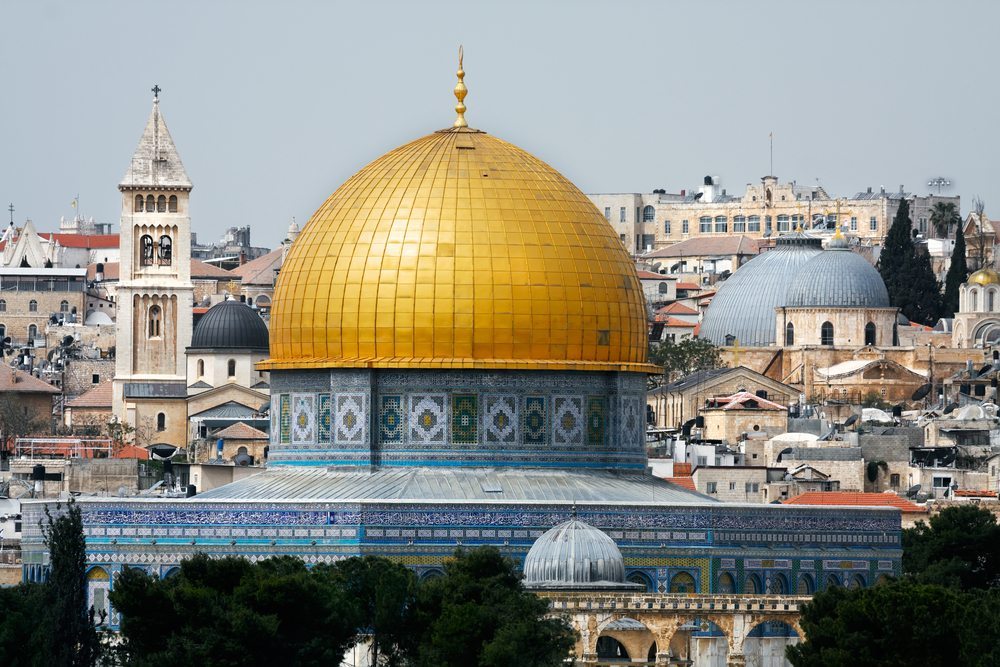
The Dome of the Rock on Jerusalem’s Eastern Hill. In the background, the two grey dome of the Church of the Holy Sepulchre on the Western Hill.
Many people are aware that ancient Rome was built upon seven hills. Fewer people know that ancient Jerusalem was built upon two hills. These are two oblong-shaped ridges that lay side by side, known simply as the Eastern Hill and the Western Hill. Between them runs a now filled-up wadi, which Josephus calls the “Valley of the Cheesemakers” (Greek: Tyropoeon).
Josephus’ most famous description of the city is found in book 5 of the Jewish Wars.
…αὐτὴ μὲν ὑπὲρ δύο λόφων ἀντιπρόσωπος ἔκτιστο μέσῃ φάραγγι διῃρημένων, εἰς ἣν ἐπάλληλοι κατέληγον αἱ οἰκίαι. τῶν δὲ λόφων ὁ μὲν τὴν ἄνω πόλιν ἔχων ὑψηλότερός τε πολλῷ καὶ τὸ μῆκος ἰθύτερος ἦν… ἡ δὲ τῶν τυροποιῶν προσαγορευομένη φάραγξ, ἣν ἔφαμεν τόν τε τῆς ἄνω πόλεως καὶ τὸν κάτω λόφον διαστέλλειν, καθήκει μέχρι Σιλωᾶς.
The city was built upon two hills, which are opposite to one another, and have a valley to divide them; at which valley the corresponding rows of houses on both hills end. Of these hills, that which contains the upper city is much higher, and in length more direct…Now the Valley of the Cheesemakers, as it was called, and was that which we told you before distinguished the hill of the upper city from that of the lower, extended as far as Siloam. (BJ V.136,140)
In this map we can clearly seen the two hills referred to by Josephus hiding beneath the city. The Eastern Hill is marked “Lower City” and the Western Hill is marked “Upper City”. They are separated by the valley marked “Tyropoeon”.
More than three millennia of human building and destruction have largely obscured the natural topography of the city, but one can still sense these two hills lurking beneath the streets of the Old City. This photo shows an example of the many stairs that make up the alleyways of the Old City.
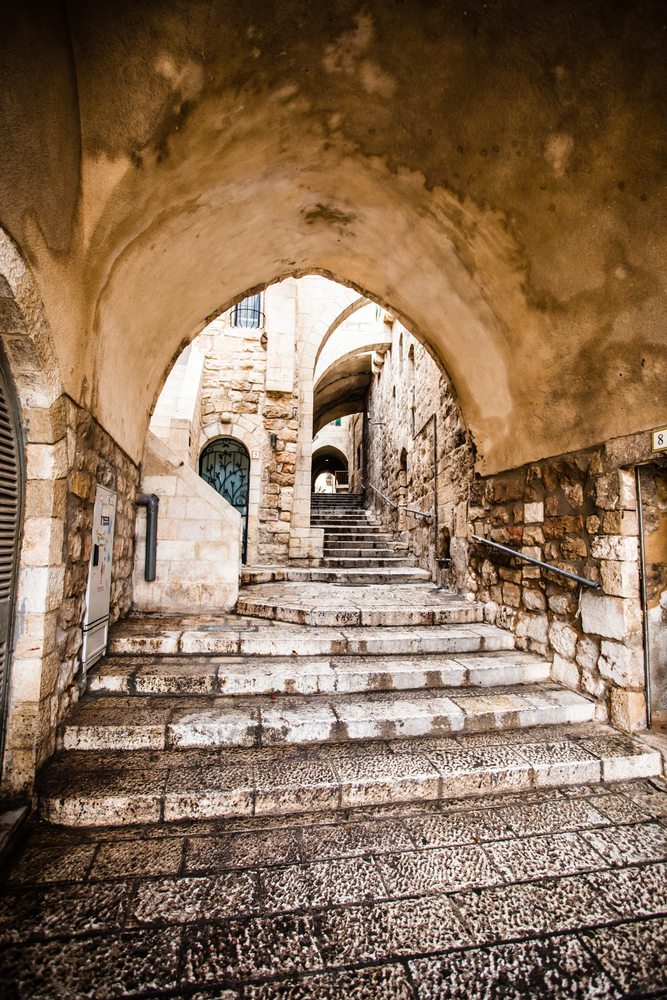
Steps leading out of the Central Valley up the Western Hill in the Jewish Quarter of the Old City of Jerusalem
Interestingly, despite the numerous layers of architecture that have accumulated on these two hills, both contain sacred sites where the original limestone bedrock has been left exposed. The Eastern Hill contains a rock known in Hebrew as Even HaShetiyah (“Foundation Stone”), which today is covered by the Dome of the Rock. The Western Hill contains a rock known in Aramaic as Golgotha (“Skull”), which today is covered by the Church of the Holy Sepulchre. Let’s take a closer look at each one of these sacred pieces of Jerusalem’s bedrock.
First, the Eastern Hill’s sacred rock: Even HaShetiyah (אבן השתייה). This is the name given by the Talmud to the “foundation stone” where according to Jewish tradition, the creation of the world began and upon which both Jewish Temples were built. The First Temple built by Solomon in about 960 BCE contained three chambers, increasing levels of holiness. The innermost third room – known as the Holy of Holies (Hebrew, Kodesh HaKodashim) – was the most sacred. This tripartite layout is very similar to the layout of Iron Age temples found by archaeologists in Syria, an indication that the Israelites were not all that different from their Canaanite neighbors. But rather than containing a statue of the god as the Canaanite temples did, the Israelite Holy of Holies contained the Ark of the Covenant, which held the tablets of the Law.
This First Temple was destroyed by the Babylonians in 586 BCE, and rebuilt on the same site approximately seventy years later. This Second Temple paled in comparison to the original Solomonic Temple and was eventually overhauled by Herod the Great in the final decades of the first century BCE. The Holy of Holies in the Herodian temple no longer contained the Ark, but was still only entered by the High Priest once a year on the festival of Yom Kippur. This photograph shows the model of Second Temple Era Jerusalem which is found at the Israel Museum.
These three structures all contained a similar layout, in which the Holy of Holies was located in precisely the same place: the Foundation Stone. The Bible indicates that prior to becoming the basis of the Temple, this stone was originally “the threshing floor of Araunah the Jebusite” (2 Samuel 24:18-23). According to most scholars, the exact site of the Holy of Holies, is the same spot currently occupied by the golden Dome of the Rock. This shrine was built in 688-91 CE by Abd al-Malik and commemorates the site of Mohammed’s ascension to heaven (al-Miraj). Archaeologists have never been permitted to dig here, so all theories about the pre-Muslim history of this site involve a lot of guesswork. But we know that the Dome of the Rock is indeed built upon a rock. This is a photograph of that bedrock, which Muslims call the Sakra and claim bears the footprint of Mohammed. Many scholars think that the incisions in the stone seen here were designed to hold the Ark of the Covenant in place when the Temples covered the rock.
Let us now have a look at the sacred stone on Jerusalem’s Western Hill. The Gospel of John tells us that on Good Friday Jesus “went out” of the walled city of Jerusalem and was crucified upon a rocky hill named “the Place of the Skull, which in Hebrew is called Golgotha” (John 19:17). The most probable location for Golgotha is the traditional site located within the Church of the Holy Sepulchre, pictured here.
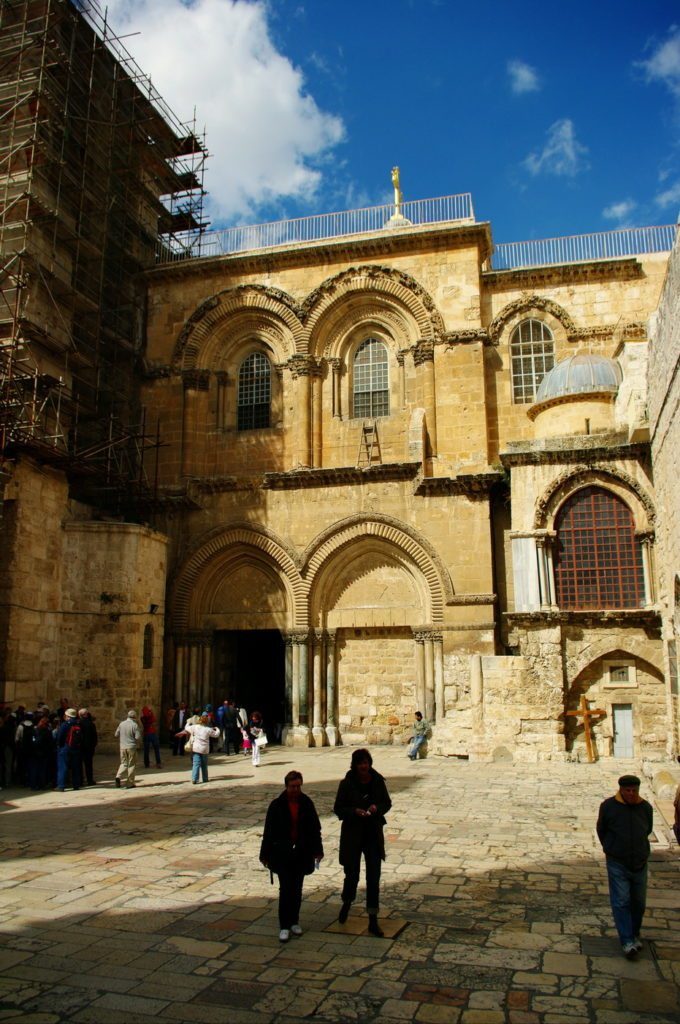
The “parvis” (courtyard) in front of the Church of the Holy Sepulchre. Most of the facade of the church dates to the 12th century and was built to commemorate the 50th anniversary of the Crusader conquest of Jerusalem. Behind the red window to the right is the chapel containing the rock of Golgotha.
Inside the church we find the rock of Golgotha almost entirely concealed beneath this very lavishly decorated Greek Orthodox chapel. In the photograph below we can see a pilgrim prostrating himself beneath the altar, placing his hand inside the crack in the stone, where the cross of Jesus was placed.
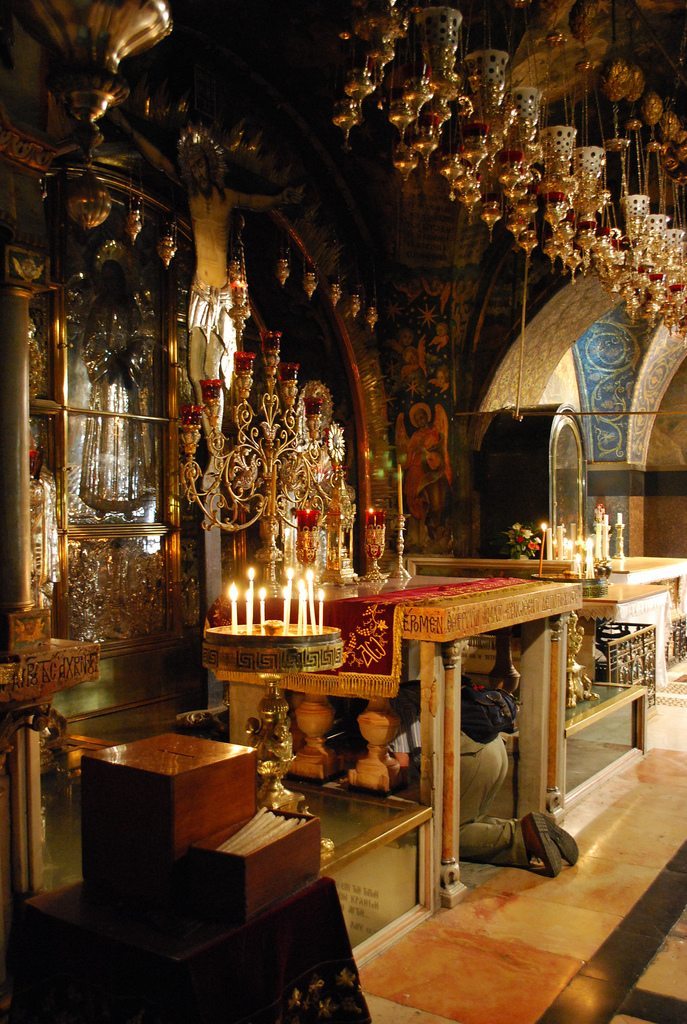
The 12th station of the Via Dolorosa (Way of Sorrows), the Greek chapel covering the Rock of Golgotha. In the background you can see the 11th station, the Roman Catholic chapel containing the site where Jesus was nailed to the cross.
Over the ages many homiletic interpretations have tried to explain the meaning of the name Golgotha. But why was it originally given this name? Contrary to the stone upon the Eastern Hill, this site has been excavated. Archaeologists have discovered that this area was formerly outside the city walls and used as a stone quarry for hundreds of years. In the center of this excavation pit a large rounded block of stone was left unquarried because it was cracked, and therefore useless for building purposes. This protrusion was likely given the name “skull” by the locals because from afar it looked like a great white bald head emerging from the ground. Eventually the Romans conquered Jerusalem and turned this abandoned quarry into their main site for public executions. It was very close to the city and contained an elevated platform which the crowds could easily see. Upon the protruding “Skull Rock” the Romans no doubt crucified thousands of rebellious Jews whose skulls came to litter the ground, giving its original name an additional layer of meaning.
In this post, we have looked at Jerusalem’s two hills and seen that each contains a sacred site which is in fact an exposed fragment of the bedrock. Almost everywhere else in the city the bedrock has been deeply covered by centuries of habitation, but in these two sites it has been left bare. Interestingly, both Judaism and Islam hold the eastern rock to be the sacred center of Jerusalem; Christianity is unique in its sanctification of the western rock.



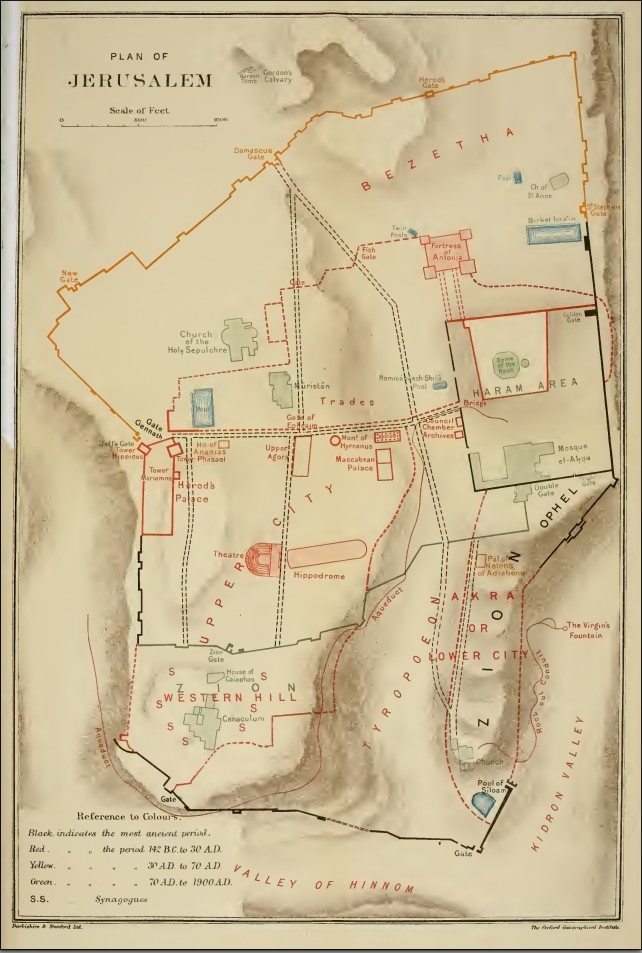


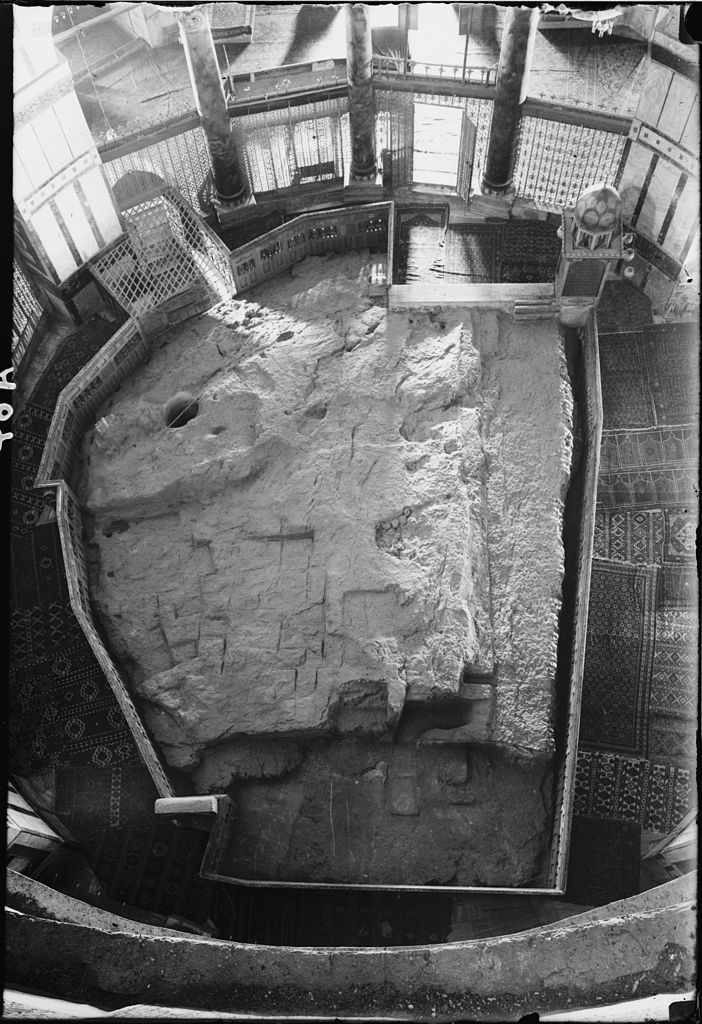
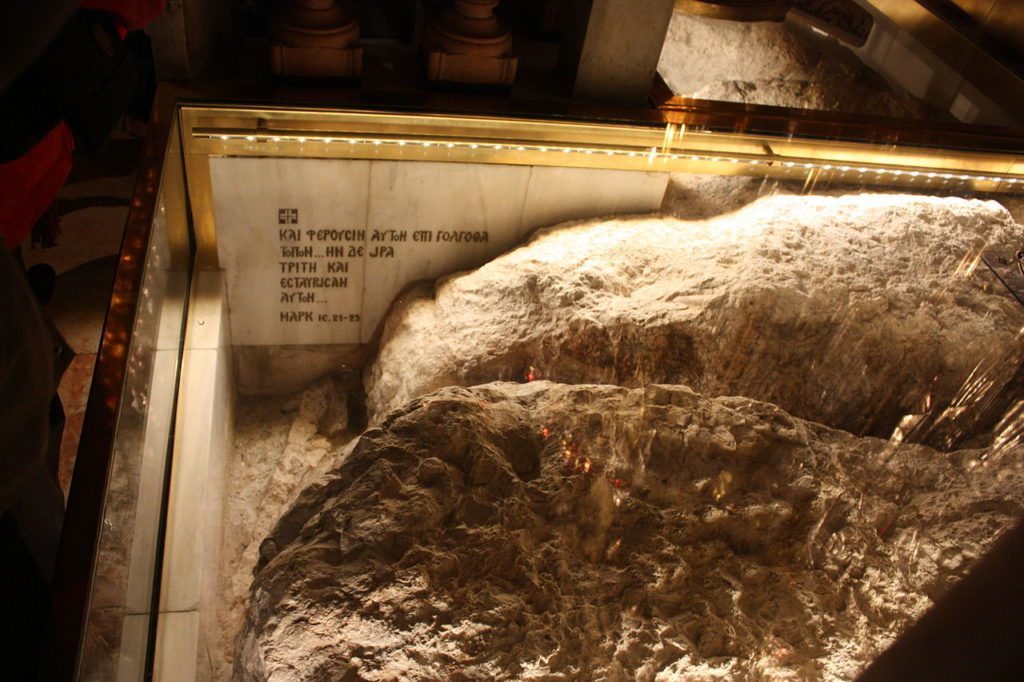



Dear Rhonda and friends,
You have all missed it, by about a mile. The true Temple Mount may be seen at Ammunition Hill. The Haram esh Sharif is the work of Constantine the Great, built to establish the Well of Souls, beneath the Dome, as the tomb of Christ.
What if I told you that the actual location of the original Temples (both Solomon’s and Zerubbabel’s, aka Herod’s) are NOT where Michael Avi-Yonah put them in the model that is at the museum, but rather, in the City of David, to the southwest of where the ‘Temple Mount’ is? Josephus Flavius and the Maccabean account (both first century eyewitnesses) state this, but Avi-Yonah completely dismissed their accounts. The ‘Temple Mount’ where the Dome of the Rock is, is actually Antonia’s Fortress. The Muslims built their mosque NOT on Holy ground, but on the Roman soldiers’ fort! What an insult that will be, when this is realized, to both Israelis and the world, and to the Muslims, especially, since they thought they were building over the temples. The crumbling stairs to the south of the ‘Temple Mount’ LEAD to the location of where the temples stood, and this area is already under the exclusive control of Israel, located in a national park.
BTW, the Shekinah LEFT the location of the previous temples, and will re-appear on the Mt. of Olives, which is the highest mountain in the area. The Bible states this has happened. The Shekinah is a statist object… wherever it moves to, that’s the Holy Ground. Once it leaves an area, that area becomes ‘common ground’ again, and it means nothing.